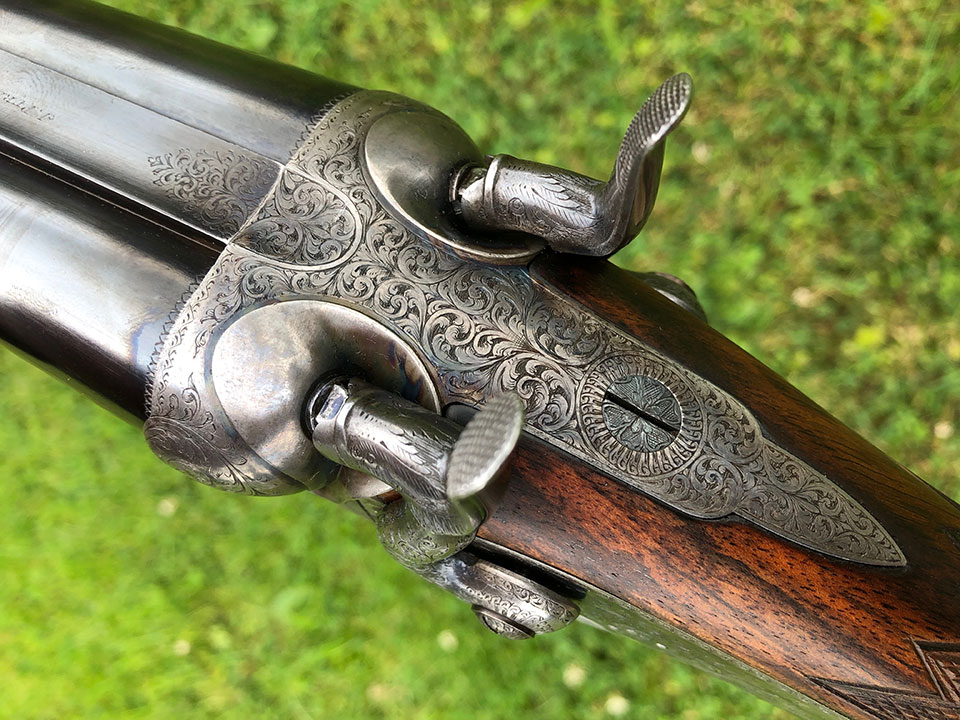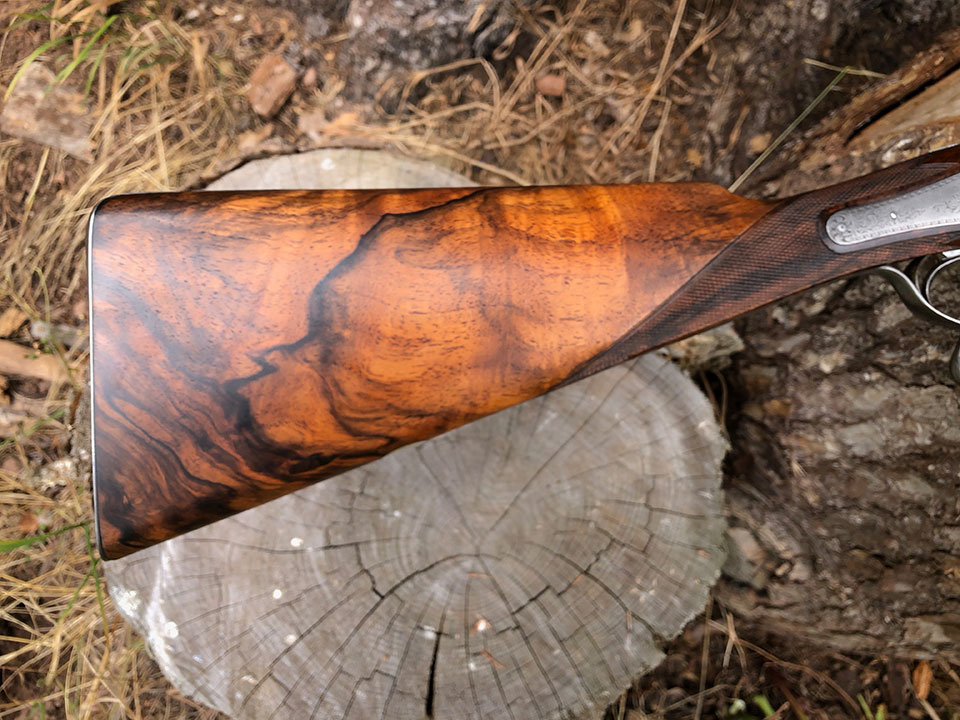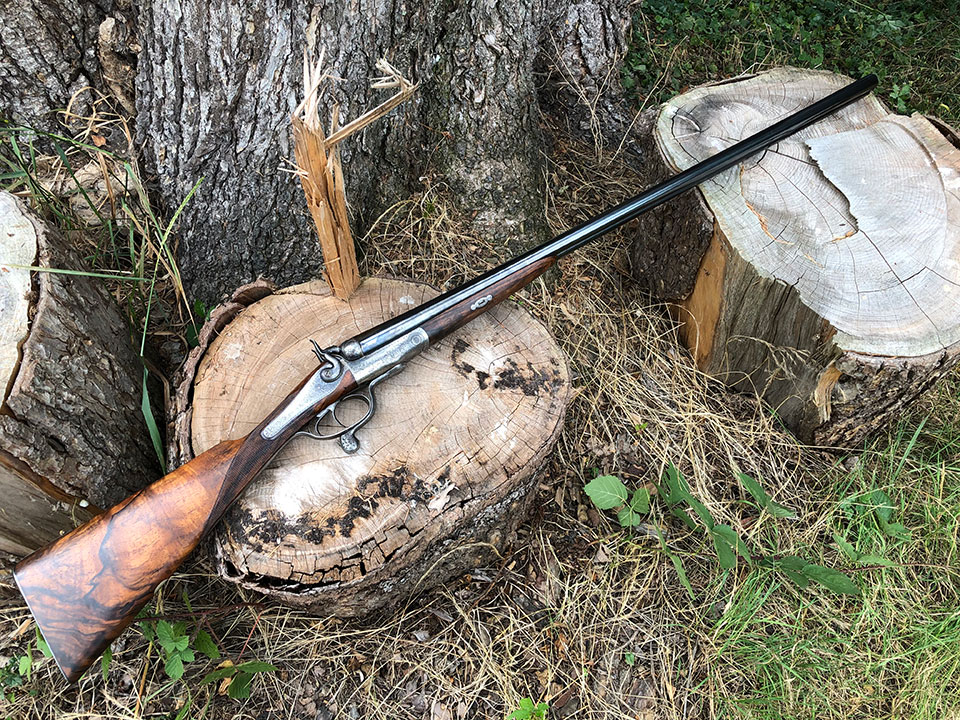The story of Scottish eccentric and avid gun collector, Charles Gordon, creates a particular and peculiar episode in the time-line of sporting gun development in Britain.
We generally see gun mechanisms evolve as new patents improve on the standard forms of the day and the style of guns changes to suit the shooting fashions of the time.
Most guns fit nicely into their historical context. However, Charles Gordon guns do not. Gordon, as many readers will know, was a wealthy ‘eccentric’ who was declared ‘mad’ in 1908, when his money began to run out.
From Halmyre House, his Scottish estate, he ordered over two hundred guns and rifles from John Dickson and a number from other makers. All were superb quality, cased to the highest possible standard, with accessories, and made to his specific orders. His orders were always bizarre.
The Purdey we are going to examine here is one such gun, built in 1899, yet unlike any other gun built at that time for anyone. Its features are the oddest combination of what was then modern and what was obsolete.
In its favour from a practical perspective, it is, at least, a centre-fire gun. Gordon ordered plenty of flint-lock, percussion guns and tube locks when they were well out-of-date.
The gun is perhaps best understood if we examine each of its main characteristics.
Non-rebound Locks. Rebound locks were common by 1870 and by 1899 the hammerless side-lock had been Purdey’s staple action for nineteen years. Hammer guns were still being made but non-rebound locks were thirty years out-of-date.
Chopper-lump, 34”, Whitworth Steel Barrels, with 2 1/2” chambers. Regulated for 3 1/4 drams of black powder with 1 1/4oz of No.6 shot. Patterned to give 162 pellets in a 30” circle at 40 yards. Whitworth steel was promoted by Purdey as of more reliable quality than Damascus and he used it from the 1880s. By 1900 it was widespread.
The chopper-lump system of construction was well established and these barrels would have been appropriate on a side-lock ejector. However, the length is bizarre. Most 12-bore guns were being made with 30” barrels and 34” would be more appropriate for a double 8-bore Purdey of the time.
Massive frame with side-clips and back-action, peninsular lock plates.The weight of the gun when delivered was 9lbs 9oz and heavy enough to withstand huge charges, yet it was regulated and chambered for a standard pigeon load of 1 1/4oz of shot, more commonly found on guns two or three pounds lighter in weight
Jones under-lever & screw-grip operating mechanism. In the era of the hammerless ejector, the 1859 Jones under-lever was not commonly used except for wild-fowling guns and cheaper grade guns. It is a strong mechanism but slow. At the time most Purdey hammer guns were top-lever operated.
Steel butt plate with extension over the heel and onto the top of the butt stock. Steel butt plates date from muzzle loading days and were phased-out during the eighteen fifties and sixties.
Wedge and escutcheon forend bolt. Like the butt-plate, the wedge and escutcheon stems form muzzle loading days, though it was common into the late 1860s. By the date of production, an Anson pushrod was the norm at Purdey.
Purdey records show the gun as ‘A best 12-bore hammer gun, back action, non-rebound locks, lever-over-guard, 34” Whitworth barrels, bolted forend, no chequer on fore-part, clip sides’.
No. 16410 was delivered in April 1899. It was actioned by Joe Thompson, barrelled by George Aston, Stocked by Lumsden and finished by Russell. The cost was £73 plus £13. 14s for the case and fittings.
The gun is very much of the quality one expects from Purdey, with a lovely French walnut stock, chequered at hand but not at the forend (another Gordon anomaly). Engraving is of large scrolls more evocative of the 1840s than the 1890s, though the dolphin hammers are very much the norm for the time.
Gordon is believed to never have fired his guns, for him collecting was enough. Many, therefore, remain in very good condition to this day.
Like all Gordon’s guns, the Purdey was sold at auction in 1908, when his half-sisters had him declared of unsound mind and incapable of handling his finances. Records suggest it probably sold for about one pound.
Since its sale in 1908, the gun has undergone some changes. It now weighs 9lbs 7oz, has had the chambers extended to 3” and been re-proofed. The chokes, originally open, have been back bored to provide 5 thou’ in the Right and 7 thou’ in the left: essentially these amount to ‘Improved Cylinder’ and will help produce tighter patterns.
Even with relatively open muzzles, the Gordon Purdey has proven effective at long range. The previous owner bought it as a high pheasant gun and used it successfully for the purpose for several seasons.
The gun’s specification originally made little sense. Its weight and long barrels suggest a long-range gun but the short chambers and open chokes did not match those characteristics.
With the longer chambers and tighter choke constrictions it now has, it looks more fit for purpose. Some may argue that Improved Cylinder does not constitute a lot of improvement over Cylinder but choke does not work incrementally as one might imagine. The greatest benefit is achieved when tightening from Cylinder to Improved Cylinder.
Most improvement is observed between zero choke and twenty thou’ (or points) of choke. After that, very little difference is reliably discernible. Cartridge choice is a key factor, as studies have shown wide variation in performance.
The key to improving effective range is ensuring the pellets have sufficient weight to penetrate at long range and that the pattern is full enough to ensure a sufficient number of strikes on the bird. The longer chambers enable the cartridge to be filled with more, bigger, shot; thereby achieving that aim. It is then up to the shooter to be accurate enough to put the pattern on the bird at the range at which it will be engaged.
First tests on the clay range showed the gun to be very stable and smooth to swing, breaking high pheasant targets comfortably. Test cartridges began with 21g No.7 shot, went through 28g and 30g No.6 shot and up to 32g No.5 shot. From Express ‘Super Light’ to Eley Zenith, the weight of the gun, predictably, tamed recoil completely.
This is one of only a few Gordon guns that is of a configuration that makes it a useful shotgun today: all be it only for a very specialised discipline. Whilst being well-balanced; with a weight close to ten pounds, it is not a gun anyone would want to swing all day.
Most of Gordon’s guns were ordered from John Dickson but he did buy from Purdey and other gunmakers. A similar gun; Purdey No.14986 is in Australia currently. It was sold in September 1894 and is similar to 16410 in that it has non-rebounding back-locks, long Whitworth steel barrels (32”), is of heavy weight (8lbs 5oz) and has similar large scroll engraving and the same heel plate. It also has no chequer on the forend.
It cost £73 plus another £14. 17s for case and accessories. I was offered this gun while writing this article. Actually, I was first offered it four years ago but overlooked its configuration and failed to identify it as a Gordon gun.
In total, Gordon ordered fifteen guns from Purdey between 1894 and 1904.
One must consider the cost of these guns to Gordon at the time. He appeared to be buying at whim. The financial outlay was significant but not what it would cost today. Best guns have increased in price massively compared to most items.
Gun 16410, in total, cost Gordon £92. 5s. 6d, in 1894. To draw some comparison to today’s money, that sum would have the same general buying power as £12,000. In other terms, of comparable expenditure to the gentry, it was enough to pay the entire annual wages of one’s butler, cook and gardener.
The Charles Gordon story is a fascinating one, nicely recounted in Donald Dallas’s book ‘Magnificent Madness’. His bizarre guns emerge from time to time to confuse and amuse us. In the case of No.16410, it has grown into a specialist high bird gun and will see another century of action, with a little luck.
Published by Vintage Guns Ltd on




